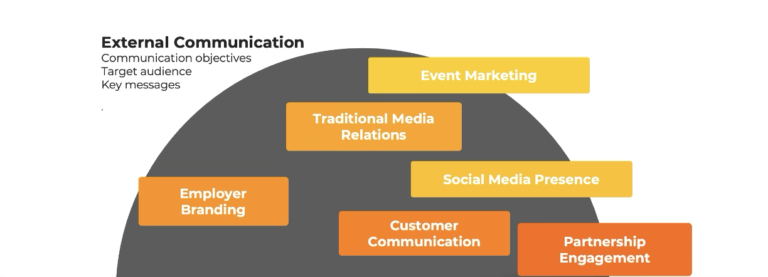Supporting our clients in business development, we often observe that companies’ external communication is random and results from ad hoc actions, reactions to market events, PR crises, or spontaneous marketing ideas. Meanwhile, successful companies reverse this logic: the market should react to the company’s thoughtful communication activities, not the other way around.

At Byzzpath, we show how to develop an external communication strategy that positions the company as a market leader, not a reactive observer.
Communication as a Strategic Business Tool
Effective external communication must be targeted and support specific business objectives. It’s not enough to simply “be present” online, you need to know why and for whom. The main goals that professional external communication should achieve are:
- Acquiring new customers – by building brand awareness and presenting the value the company offers to its audience.
- Building a strong brand – consistently communicating unique features and values that distinguish the company from competitors.
- Attracting talent – positioning as an attractive employer in the eyes of experts and specialists in the industry.
- Building investor trust – transparent communication about results, plans, and the company’s development vision.
Long-term Strategy vs. Short-term Actions
The most effective communication results from a thoughtful strategy that combines long-term perspective with flexibility in short-term actions.
Long-term strategy should define:
- Communication vision and mission of the company
- Key target groups and their characteristics
- Main messages and values to convey
- Communication channels and their hierarchy of importance
- Success metrics and KPIs
Short-term actions should be flexible and respond to:
- Current industry trends
- Customer needs and questions
- Competitor activities
- Changes in social media platform algorithms
- Current events and marketing opportunities
Key Elements of Professional External Communication
- Message Consistency
All communication channels must speak with one voice. Employees should understand the brand vision and their roles in its realization, becoming authentic company ambassadors. - Targeted Content
Creating valuable content: articles, videos, infographics, that responds to specific target group needs and positions the company as an expert in its field. - Strategic Channel Utilization
Choosing appropriate communication platforms depending on business nature: LinkedIn for B2B companies, Instagram for visual products, or specialized industry forums. - Systematic Actions
Developing a detailed weekly plan with specific activities, content publication schedule, and results analysis.
| Company | Main Communication Goal | Long-term Strategy | Short-term Actions | Channels |
|---|---|---|---|---|
| Apple | Premium brand building, loyalty increase | Minimalism, innovation, “Think Different” | Launch events, seasonal campaigns, product teasers | Website, social media, PR events, retail |
| Professional acquisition, employer branding | “Professional network”, “Career growth” | Industry reports, webinars, thought leadership content | LinkedIn platform, blog, events | |
| Nike | Lifestyle brand building, customer loyalty | “Just Do It”, inspiration through sport | Athlete collaborations, seasonal collections, social causes | Instagram, YouTube, sponsoring, retail |
| HubSpot | Lead generation, marketing thought leadership | “Inbound marketing”, education-first approach | Free tools, educational content, certification programs | Blog, social media, webinars, conferences |
| Patagonia | Socially responsible brand building | Environmental activism, “Don’t buy this jacket” | Environmental campaigns, activism content, transparency reports | Website, documentary films, social media, PR |
Practical Implementation
Professionalizing external communication requires a systematic approach:
- Current communication audit – assessing message consistency across all channels
- Strategy definition – determining goals, target groups, and key messages
- Action plan development – concrete schedule with responsibility assignment
- Implementation and monitoring – regular results tracking and action optimization
- Team awareness – ensuring all employees understand and support the communication strategy
Summary
Professional external communication is not a cost, but an investment in the company’s future. When communication is strategic, consistent, and targeted at specific business goals, it becomes a powerful growth tool. Companies that understand this and consistently implement thoughtful communication strategies gain competitive advantage and build lasting relationships with their stakeholders.
Remember: in today’s world, every company communicates with its environment, but only those that do it professionally and strategically achieve their ambitious business goals.
Byzzpath
More information on building a comprehensive external communication strategy can be found within the ByzzPath Framework.
